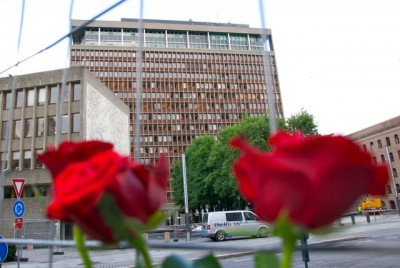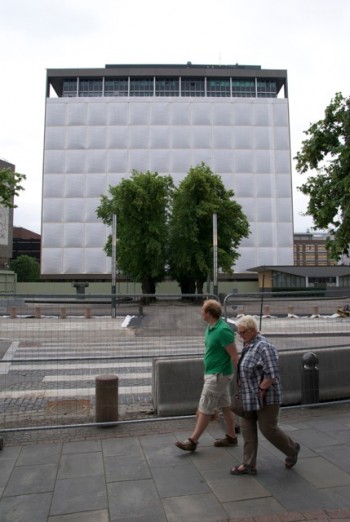The former high-rise heart of Norway’s government’s headquarters survived a bombing three years ago and now won’t be demolished either. Prime Minister Erna Solberg confirmed on Sunday that the 17-story building known as “Høyblokken” will remain part of a newly redeveloped government complex in downtown Oslo.

Solberg and her fellow government minister in charge of municipalities, Jan Tore Sanner, announced that they’d agreed on a redevelopment plan for the complex, three years after a right-wing extremist detonated a powerful bomb just outside Høyblokken’s main entrance on July 22, 2011. Eight persons were killed and many others injured in the attack that heavily damaged the high-rise that housed the Justice Ministry on floors two to 12 and the Office of the Prime Minister on floors 13 to 17.
The building remains structurally sound, however, according to various engineering studies carried out during the past two years, and support for its preservation has steadily been growing. A unique “open house” last year that allowed visitors inside the gutted building attracted thousands of people.

“We have chosen what’s called ‘konsept Øst’ (Concept East),” Solberg told reporters at a press conference Sunday afternoon. She said the plan will also eventually allow the reopening of Akersgaten, the main street running through the area in front of the high-rise, to vehicular traffic.
The high-rise’s facade and its built-in artwork inside and outside will be preserved, Solberg said, “but the plan opens up for a higher addition to the building for expansion behind it.”
The adjacent low-rise building known as Y-blokken, which housed the education ministry, will be torn down, however, and replaced with new government offices. Sanner said the damage to the building that’s shaped like a “Y” jeopardized its structural safety, and the government needs to make better use of the space. He said the government wants to retain openness and more greenery around the complex, but stressed that the artwork sandblasted on the walls of the building will be peserved. They are the work of artists including Pablo Picasso and Carl Nesjar.
The adjacent so-called “S-blokken,” which housed the health and labour ministries, will also be torn down with demolition beginning this autumn. The much newer building housing the ministries of trade and oil and energy will also be demolished, making way for the expansion of the high-rise and new ministerial offices.
While the government’s plans are in keeping with professional recommendations and public sentiment urging preservation of Høyblokken, they are not without controversy. Representatives for state employees in all the ministries complained to newspaper Dagsavisen last week that they feel overlooked in the redevelopment process, and that their needs and desires haven’t been heard.
“It’s important that we’re allowed to be part of the process,” Inger Riis-Johannessen, representing the Justice Ministry, told Dagsavisen. She and 48 other representatives of ministry employees sent a letter to Sanner in which they claimed they hadn’t been given any influence over the redevelopment project. They’re concerned that the new offices won’t be large enough to accommodate growth, they object to the prospect of losing their individual offices if “open landscape” design is used and they want to avoid having to move out of downtown again if they run out of space.
Eivind Dale, of Sanner’s ministry, said employees have been kept informed of developments and included in several meetings. “We want a modern and functional government complex and will of course involve the employees in the process further. He stressed that no detailed decisions had yet been made.
Norway’s government ministries had to be hastily relocated after the bombing in 2011 and now are spread around the city. A representative for a survivors’ group welcomed the new redevelopment plans. The project is expected to cost at least NOK 16 billion (USD 2.6 billion).
newsinenglish.no/Nina Berglund

